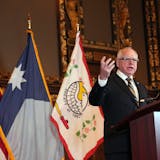Minnesota took the top spot in a national annual ranking that scores the well-being of U.S. children.
But the state's children of color don't fare as well.
In the 2016 Kids Count ranking released Tuesday by the Annie E. Casey Foundation, Minnesota was No. 1 in the overall child well-being ranking that's based on 16 indicators. The indicators cover economic well-being, education, health, and family and community. It was the second consecutive year the state ranked first overall and the seventh time it took the top spot since the rankings started in 1990.
In a state where 71 percent of the children are white, Minnesota ranked first in health, third in economic well-being, fourth in family and community, and sixth in education.
"Those indicators are predictors of future outcomes and success throughout childhood and into adulthood," said Stephanie Hogenson, research and policy director for the Children's Defense Fund — Minnesota.
"We've been a leader in providing access to health coverage and care," she said. "We have one of the strongest economies in the country. We have some of the strongest and most reputable education systems and programs in the country."
But when the data is broken down by race and ethnicity, "we start to see some real disparities," Hogenson said. "So, just looking at our No. 1 rank and celebrating that is not appropriate because … we have some of the highest rates of black and Asian children living in lower-income households. Some of the highest rates of high school students not graduating on time are across most populations of color. [It's] the same with uninsured rates."
The good news is that Minnesota knows what works for kids, Hogenson said. "We can get children to be successful, and we've done that for our white population," she said. "So, what we need to do is take those programs and policies that are working and make sure that they're accessible and culturally relevant for children of color and American Indian children."



